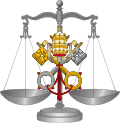Canonization
The canonization of confessors or martyrs might be taken up as soon as two miracles were reported to have been worked at their intercession, after the pontifical permission of public veneration as described above. At this stage it was only required that the two miracles worked after the permission awarding a public cultus be discussed in three meetings of the congregation. The discussion proceeded in the ordinary way; if the miracles were confirmed, another meeting (super tuto) was held. The pope then issued a Bull of Canonization in which he not only permitted, but commanded, the public cultus, or veneration, of the saint. [6]
It may be easily conjectured that considerable time must elapse before any cause of beatification or canonization could be conducted, from the first steps of the information, inquiry, or process, to the issuing of the decree super tuto. According to the constitution of this Congregation, more than one important discussion (dubia maiora) could not be proposed at the same time. It must be remembered: [6]
- that the same cardinals and consultors must vote in all discussions;
- that there was but one promotor of the Faith and one sub-promotor, who alone had charge of all observations to be made with regard to the dubia; and
- that these cardinals and consultors had to treat questions of ritual as well as processes of canonization and beatification.
To execute all this business there was but one weekly meeting (congressus), a kind of minor congregation in which only the cardinal prefect and the major officials voted; in it less important and practical questions were settled regarding rites as well as causes, and answers were given, and rescripts which the Pope afterwards verbally approved. The other meetings of the congregation (ordinary, rotal, and "upon virtues and miracles") might be as few as sixteen in the course of the year. Some other cause must therefore be found for the slow progress of causes of beatification or canonization than a lack of good will or activity on the part of the Congregation of Rites. [6]
This page is based on this
Wikipedia article Text is available under the
CC BY-SA 4.0 license; additional terms may apply.
Images, videos and audio are available under their respective licenses.
